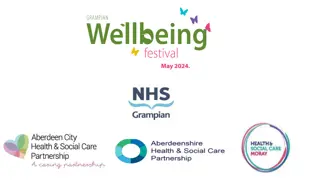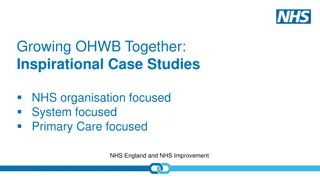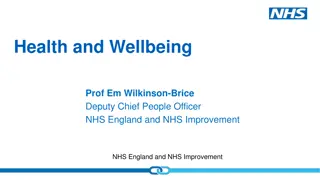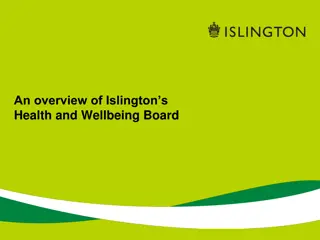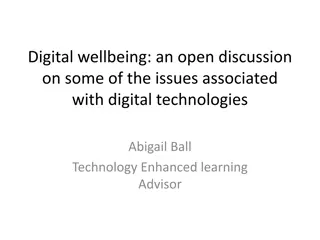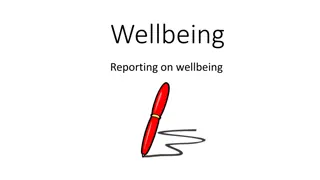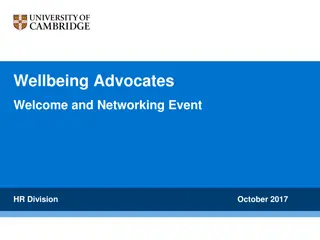Exploring Leadership Through the Lens of Health and Wellbeing
This content delves into the importance of leadership in promoting health and wellbeing, specifically focusing on the connection between leadership behaviors and fostering positive approaches to health and wellbeing in individuals, teams, and organizations. It highlights initiatives within the NHS to prioritize health and wellbeing, encouraging supportive conversations, personalized plans, and holistic frameworks aimed at cultivating a culture of wellbeing. Stakeholders are engaged through various activities to refine ideas, identify priorities, and share best practices for healthy leadership behaviors.
Download Presentation

Please find below an Image/Link to download the presentation.
The content on the website is provided AS IS for your information and personal use only. It may not be sold, licensed, or shared on other websites without obtaining consent from the author. Download presentation by click this link. If you encounter any issues during the download, it is possible that the publisher has removed the file from their server.
E N D
Presentation Transcript
Leadership Through the Lens of Leadership Through the Lens of Health and Wellbeing Health and Wellbeing
Agenda Agenda Welcome Scene setting: National Regional - HWB journey at NHS NWLA The commission The approach The outputs Where we need your help and how to get involved Q&A
If we try to secure the well-being of others, we will at the same time, create the conditions for our own
Connecting and Sharing Connecting and Sharing What are you doing to secure the well-being of others and yourself?
Scene setting Scene setting - - HWB Culture Journey HWB Culture Journey
NHSEI NHSEI A Culture of Wellbeing A Culture of Wellbeing Health and Wellbeing Conversations Supportive conversation about wellbeing, in and out of work For all NHS People, at least annually, to develop a personalised plan Guidance and support materials launching imminently Wellbeing Guardians Board level Champion for Wellbeing Introduced over the next 12 months Health and Wellbeing Framework Refreshed early 2021 More holistic, additional focus on culture and wellbeing
NHS NWLA NHS NWLA - - Scope of the Commission Scope of the Commission Scope - Commissioned exploratory work to support NHS NWLA Health and Wellbeing (HWB) leadership development workstream activity, focused on the relationship between HWB and leadership. Intent Explore and shape the leadership behaviours that enable and encourage positive approaches to HWB for individuals, teams and organisations, enabling positive and healthy workplace cultures.
Approach to working with stakeholders The Approach The Approach Creating Connecting Validating Exploring concepts and models Sharing findings Testing ideas Networks in the NW system Social media campaign for reach Sharing experience and ideas Refining ideas Identifying priorities Creating case studies to share Identify healthy leadership behaviours from literature Identify healthy leadership behaviours data collection Developing the healthy leadership competency framework Validating the healthy leadership framework Final report Desk top review (peer reviewed) Framework which outlines leadership behaviours that promote health and wellbeing in the workplace Insights from stakeholders around what could be done embed the framework Map the final framework against 3 existing frameworks to validate e.g. Healthcare Leadership Model, HSE Management Standards Framework, CIPD framework Integrate the data into the initial behaviour framework. Validate and refine the framework with focus groups Survey and Twitter chat 1:1 interview Twitter chat and supplementary survey for those not able to contribute via twitter Desktop literate review and validation of the research with HWB experts - peer review by Prof Cary Cooper, Dr Steve Boorman, Jean Jenkins
The Outputs The Outputs Scoping exercise to shed light on leadership through the lens of HWB, including: Review of literature and evidence base Engagement and testing conversations with key stakeholders Utilising these insights to shape a framework which outlines the leadership behaviours that encourage and determine a culture of health and wellbeing for individuals, teams and organisations Insights from stakeholders around what could be done on a system level to promote a culture of health and wellbeing Spinoff s International Stress Management Association (ISMA) invitation to publish in their commemorative book (which will be published as part of their online global stress and wellbeing summit (https://isma.org.uk/isma-online-global- stress-and-wellbeing-summit)
Healthy Leadership Twitter Chat Healthy Leadership Twitter Chat 29 29th th September 2020 September 2020 Aim: Engage and connect in a conversation to scope out the leadership behaviours that enable, encourage and promote employee wellbeing in the workplace. Twitter Chat Questions What leadership/management behaviours positively impact on health and wellbeing at work? What leadership/management behaviours negatively impact on health and wellbeing at work? What things do you do personally that positively impact on your health and wellbeing at work? What gets in the way of you looking after your own health and wellbeing at work? What health and wellbeing interventions have the most positive impact on health and wellbeing at work? What could the NHS NWLA do now and in the future to support the development of healthy leadership ?
Preview of the Healthy Leadership Framework Preview of the Healthy Leadership Framework
Preview of the Healthy Leadership Framework Preview of the Healthy Leadership Framework How I am Positive Presence Self Care What I do Leading Task What we do together Caring for and developing others Relating to others How I am (being) Actively engage with opportunities to understand and enhance positive mental and physical health for self and others, sharing own experience, being authentic. 13 positive behaviours and 9 negative behaviours. What I do (doing) Actively support and empower others to manage work and how it s done. 15 positive behaviours and 9 negative behaviours. What we do together (enabling) Actively empower an inclusive healthy wellness culture that mutually enables us all to bring our whole selves to work. 18 positive behaviours and 6 negative behaviours.
Leadership/management behaviours that contribute negatively to employee wellbeing Leadership/management behaviours that contribute positively to employee wellbeing 1.1+ being open, honest and transparent (authentic) 1.1- not always role modelling positive health and wellbeing behaviours (e.g. wearing long hours as a badge of honour) 1.2+ being a good health and wellbeing role model (walking the talk) 1.2- not regularly communicating about health and wellbeing How I am (being) How I am (being) 1.3+ behaving in accordance with organisational values 1.3- lacking empathy 1.4+ talking optimistically about the future and remaining positive in face of challenge (give hope) 1.4- being distant, lacking visibility and not engaging with others 1.5+ showing vulnerability and humility (willingness to be critiqued, honest when don t know the answer, acknowledging when one has made a mistake) 1.5- bring unpredictable in mood and inconsistent in behaviour 1.6+ being committed to and promoting employee health and wellbeing 1.6- lacking self-awareness 1.7+ speaking with confidence about mental health and wellbeing and taking appropriate action to support others 1.7- letting emotions get the better of oneself (e.g. show frustration and or withdraw) 1.8+ being visible, accessible, approachable 1.8- lacking transparency 1.9+ helping to create a climate where people can have fun, light-hearted upbeat humour, have a laugh 1.9- paying lip service to health and wellbeing (e.g. failing to promote what s available and/or only doing the basics) 1.10+ being self-aware and understanding how own behaviour impacts on others 1.11+ attending to and look after own health and wellbeing 1.12+ showing compassion toward self and kindness and compassion to others 1.13+ trying to always do the right thing (acting with integrity)
Leadership/management behaviours that contribute positively to employee wellbeing Leadership/management behaviours that contribute negatively to employee wellbeing 2.1+ being clear on values, expectations, setting clear objectives/goals and checking with individuals that they feel they are realistic and achievable 2.1- focusing on targets and task at the expense of health and wellbeing 2.2+ demonstrating a consistent approach (being consistent in behaviour and decisions making) 2.2- making short term demands rather than allowing planning (being reactive, changing goal posts, setting unrealistic deadlines) 2.3+ providing a compelling vision and giving clear direction 2.3- not always clarifying roles, responsibilities, objectives or acknowledging competing priorities (e.g. laissez faire management style) What I do (doing) What I do (doing) 2.4+ encouraging others to collaborate and work collectively on tasks/projects 2.4- being inflexible in one s approach (e.g. applying a blanket approach to everyone) 2.5+ being fair, flexible and pragmatic in ones approach to applying policy and I adapting ones approach to meet individual need 2.5- not always trusting others to do their job 2.6+ providing regular and timely communication, using different communication methods 2.6- making decisions without consulting others (e.g. authoritarian /autocratic /command and control/directive style) 2.7+ helping teams meet regularly to review performance, make improvements (promoting reflexivity) and share learning to innovate 2.7- being guarded and failing to provide enough communication 2.8+ flexing and modifying work scheduling to support others wellbeing and achieve work life balance 2.8- not always acting on feedback or taking action to address matters raised 2.9+ listening to, considering and seeking others ideas 2.9- not always listening, only casually listening to complaints, suggestions and ideas 2.10+ adopting the most appropriate leadership/management style depending on the context 2.11+ actively seeking feedback and taking action to address matters raised 2.12+ walking the floor to understand and acknowledge what it s like to work around here 2.13+ trusting individuals and teams, giving them the autonomy and control to do their jobs (empowerment) 2.14+ taking responsibility for ones actions and hold self to account 2.15+ tackling bullying and challenge inappropriate behaviour
Leadership/management behaviours that contribute positively to employee wellbeing 3.13+ appreciating others achievements by rewarding and recognising and celebrating success What we do together (enabling) What we do together (enabling) 3.1+ helping people connect to the wider meaning of their work, the contribution they make, creating a sense of belonging 3.14+ regularly asking people how they are 3.2+ standing alongside ones team and getting involved with what they do when they need help 3.15+ taking time to support others in their development 3.3+ respecting and valuing difference, taking an inclusive approach, recognising individuality and encouraging people to be themselves (embracing diversity) 3.4+ getting to know people/teams on an individual level formally and informally (treating them as humans not just colleagues) 3.16+ being aware of full circumstances of the people one leads/manages and finding out what motivates them makes them tick 3.17+ offering support to others 3.5+ coaching others to find their own solution (acting as a sounding board and challenging constructively) 3.6+ communicating and involving people in change management (increasing certainty and reducing uncertainty) Leadership/management behaviours that contribute negatively to employee wellbeing 3.7+ demonstrating empathy by understanding other perspectives, personal circumstances and walking in others shoes 3.1- focusing on oneself and what I want to achieve at the expense of the collective good (e.g. hero manager/leadership style) 3.8+ showing respect for others 3.2- not always appreciating difference and diversity 3.9+ encouraging and facilitating connections between people 3.3- sometimes favouring people who are more like me 3.10+ encouraging personal growth and resilience 3.4- micromanaging others and disempowering them 3.11+ encouraging learning from error (learning culture) 3.5- not always creating a safe environment to speak out (psychological safety) 3.6- giving more negative than positive feedback, blaming and criticising and finding fault 3.12+ listening actively (non-judgemental, listening to how people are feeling)
Preview of the Healthy Leadership Framework Preview of the Healthy Leadership Framework Reflections What is resonating with you about Healthy Leadership ? How do you see Healthy Leadership in your organisation, in your leaders and yourself?
We need your help. We need your help . Voting on the healthy leadership framework: 17th November - 1st December https://www.surveymonkey.co.uk/r/NWHealthyLeadership Twitter Chat: Tuesday 24th November, 6-7pm @nhsnwla #NWHealthyLeadership
Q&A Q&A
Health & Wellbeing Resources & Offers Health & Wellbeing Resources & Offers Our NHS People Health and Wellbeing Resources & Offers Our NHS People Support for Leaders Our NHS People Health and Wellbeing Conversations Our NHS People Supporting offers in difficult times Newly launched national suite of executive level offers, in particular Support in difficult Times NHS NWLA Virtual Health and Wellbeing Offers





